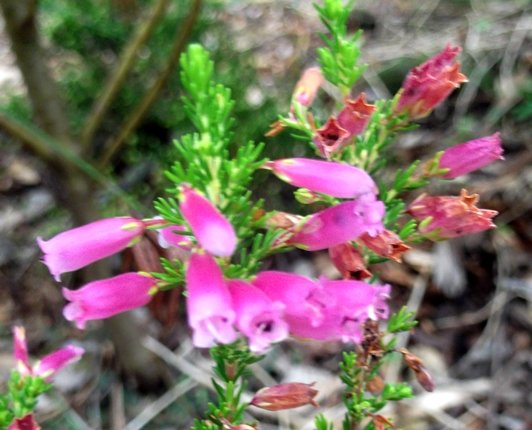Erica sitiens

Author: Ivan Lätti
Photographer: Thabo Maphisa
Erica sitiens, commonly called the thirsty heath, is an erect or sprawling shrub reaching about 90 cm in height. The common name matches the specific one, sitiens, a Latin word meaning thirsty, dry or parching. This name reflects the fact that the plant does not grow in seepage areas, probably not too thirsty after all.
According to the Baker and Oliver classification of ericas the species belongs among the Orophanes section of the genus, a category characterised by stem-tip flowers often in groups of four, the dry corollas less than 5 mm long with anthers included and leaves four-whorled. Manning and Helme have this plant among the Crested Heaths, ericas bearing urn-shaped flowers that have crests at the base of the anthers.
The needle-like leaves grow in whorls of four, from 3 mm to 8 mm long.
The flowers grow at the tips of side-shoots, solitary or in groups of up to four, aggregated in panicles. The pedicels of only 2 mm have small, scale-like bracteoles in the middle or near the base. The discoloured sepals are lance-shaped with tapering tips, up to 4 mm long and hairless.
The corolla is oblong to urn-shaped, asymmetrically inflated but this is variable. The flower colour is white or sometimes fairly pale pink in several shades. The four corolla lobes are rounded, somewhat out-curving and sometimes white on plants bearing dark coloured tubes. The corolla becomes up to 8 cm long. The eight stamens and the style are included, the ovary top-shaped, the stigma a pinhead. Flowering happens from spring to midautumn.
The species distribution is in the southwest of the Western Cape, maybe from the Cape Peninsula but mainly near the southern coast between the Hottentots Holland Mountains and the Kleinrivier Mountains.
The habitat is sandstone slopes in fynbos at elevations from 300 m to 1000 m; large stands may be seen. The habitat population is deemed of least concern early in the twenty first century (Manning and Helme, 2024; Bean and Johns, 2005; Baker and Oliver, 1967; Andrew, 2017; iNaturalist; http://redlist.sanbi.org).

